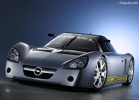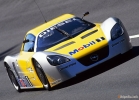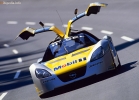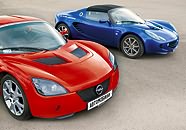Test Drive Opel Speedster 2001 - 2005 Convertible
Turbosport without sugar
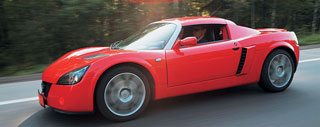 The preservation of the type and taste of the source product is the main rule of Japanese cuisine. The same principle was used by the creators of Opel Speedster.
The preservation of the type and taste of the source product is the main rule of Japanese cuisine. The same principle was used by the creators of Opel Speedster. The idea of \u200b\u200bthe purity of the design came to Kolin Chapmanu - a racer and the creator of Lotus Cars, which on the basis of aggregates of relatively modest serial cars collected very simple and very light cars. Then Lotus began to produce cars mature and more expensive, and then he bought General Motors, which also belonged to Opel, with his funny attempts to produce sports models in the 1980s. Therefore, the new Opel model with confused, but the speaking name Speedster was done together with Lotus. On her they decided to try out the style of techno. And now, let's understand how it happened that two cars created on one base (and at one plant) correspond to each other by philosophy as Zen Buddhism and Marxism-Leninism. One - the embodiment of English automotive pride, the other is the continuation of the German mass tradition
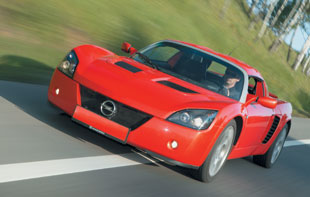 AT THE LEVEL. Evaluate the appearance of Opel Speedster Pedestrians cannot be evaluated. And even from the height of the driver of a normal car, the look is completely incorrect. The machine is the most powerful impression when you look at it from another same. Heights of this experiment in the style of techno immediately turn into sticking feline ears. And zipper becomes visible in the circle, which this model is suitable much more than someone else: Speedster is not a record holder at maximum speed, but by the dynamics of overclocking bypass any other Opel. Due to the carcass of the body from the aluminum alloy, the car weighs so much as for each L.S. The maximum power of the two-liter turbogue accounts for only 4.7 kg. Porsche Boxster - more than five.
AT THE LEVEL. Evaluate the appearance of Opel Speedster Pedestrians cannot be evaluated. And even from the height of the driver of a normal car, the look is completely incorrect. The machine is the most powerful impression when you look at it from another same. Heights of this experiment in the style of techno immediately turn into sticking feline ears. And zipper becomes visible in the circle, which this model is suitable much more than someone else: Speedster is not a record holder at maximum speed, but by the dynamics of overclocking bypass any other Opel. Due to the carcass of the body from the aluminum alloy, the car weighs so much as for each L.S. The maximum power of the two-liter turbogue accounts for only 4.7 kg. Porsche Boxster - more than five. 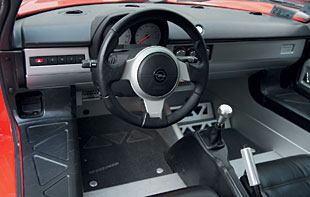 MINIMALISM. One aluminum was not limited to: the car is deprived of everything that could pass for an excess. Air conditioning? No even in the list of options. Like electrical windows. The interior decoration is reduced to a minimum, opening the noble material of the carrier frame. The instrument shield (the same as on Lotus) can also close your palm.
MINIMALISM. One aluminum was not limited to: the car is deprived of everything that could pass for an excess. Air conditioning? No even in the list of options. Like electrical windows. The interior decoration is reduced to a minimum, opening the noble material of the carrier frame. The instrument shield (the same as on Lotus) can also close your palm. Minimalism is perfectly when you watch it or read about it. Contact with reality makes think about that sometimes even in the water is worth adding if not syrup, then, as in hot shops, salt. Next to the car you begin to understand that the circle allowed before the control is limited to growth, and in width. In any case, if the roof is on the car. On our test she was, and it was not possible to remove it: this requires special hexagon keys that did not turn out. I had to produce the penetration algorithm. It turned out something like this: right foot - head - shoulders - the support part - the left leg. High (about a third of the height of the body) Wide thresholds - carcass bearing side meters. It is convenient to sit on them, but it's hard to climb through them.
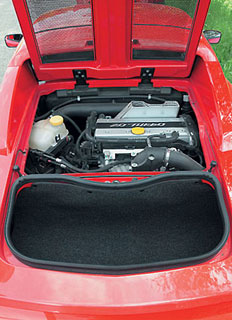 The head, embedded with the body in the cockpit, finds out that you can adjust exactly two parameters - the longitudinal position of the chair and the lumbar subport is, - pulling the air with rubber pear. The steering wheel, pedals and the angle between the back and the seat pillow are fixed once and for all. Interestingly, is it offered to buyers the opportunity to order an individual chair for their measurement, as for athletes? And then we were taught that the hands should only be slightly bent in the elbows, and here this number does not pass - the distance to the steering wheel is not enough.
The head, embedded with the body in the cockpit, finds out that you can adjust exactly two parameters - the longitudinal position of the chair and the lumbar subport is, - pulling the air with rubber pear. The steering wheel, pedals and the angle between the back and the seat pillow are fixed once and for all. Interestingly, is it offered to buyers the opportunity to order an individual chair for their measurement, as for athletes? And then we were taught that the hands should only be slightly bent in the elbows, and here this number does not pass - the distance to the steering wheel is not enough. MAXIMALISM. At one modest excessiveness of money, I did not regret: the engine starts with the button in the center of the panel. The sound is strong and pleasant, but not striking either a rumor nor imagination: probably, it is specifically to suggest a turbine when you press the accelerator to be heard. It is a pity that he cannot drown out the embrozing of the pedal of clutch: the first five thousand km this car passed in extreme tests of tests, that is, the car deliberately spoiled, chasing on the limit modes. True, a creaking clutch is normal.
The minimalism of the design is pleasantly affecting the number of impressions of the drive: engine roars, jerk - and here they are, the desired 100 km / h in five seconds. This is if you look at the speedometer. If you do not watch, but only listen to the engine and evaluate the tactile sensations, it is quite possible to give 140. Further, however, the growth of the felt speed compared to the dashboard slows down, because it's just nowhere. Nonal pressing on a strikingly light pedal causes an optimistic scream of the engine, which is unwound even when no one is taking on the pedal. There is a suspicion that with the throttle drive, also worked colleagues on tests.
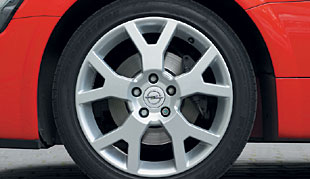 Driving this in principle does not interfere, but the constant passage is up to the arrow to leave in the red zone and the ignition of the light bulb on the tachometer scale - makes it be more accurate than I would like. However, when behind the back of 200 horses per incomplete ton of weight, the accuracy does not prevent. The lack of an amplifier does not constantly shy at all: even to a rather small ram (after which the standard steering wheel seems to be a bus) do not have to make special efforts. The only thing for what I would like to get an amplifier is to harvest shocks from the road. It is too transparent steering wheel. I would consider it an inevitable sign of pure Driver's Fun if I didn't know that it was avoided on Lotus.
Driving this in principle does not interfere, but the constant passage is up to the arrow to leave in the red zone and the ignition of the light bulb on the tachometer scale - makes it be more accurate than I would like. However, when behind the back of 200 horses per incomplete ton of weight, the accuracy does not prevent. The lack of an amplifier does not constantly shy at all: even to a rather small ram (after which the standard steering wheel seems to be a bus) do not have to make special efforts. The only thing for what I would like to get an amplifier is to harvest shocks from the road. It is too transparent steering wheel. I would consider it an inevitable sign of pure Driver's Fun if I didn't know that it was avoided on Lotus. 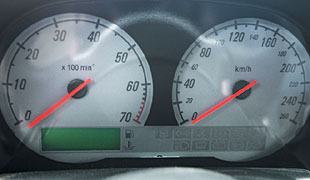 Another school. But the brake is made in the worst traditions of Opel. I was aware that they love short pedals, which should be crushed quite intensively. However, it was not very pleasant to detect how tight it happens, slowing down from one hundred thirty. Of course, the issue of habit, but again the example is remembered with Lotus, which has a pedal, on the contrary, is ligaled, but it is accurate to dispense the braking force without any straining and developments. So the difference between two machines from one plant may be much more significant than the style of appearance and emblem. Even if we are talking about a minimalist design.
Another school. But the brake is made in the worst traditions of Opel. I was aware that they love short pedals, which should be crushed quite intensively. However, it was not very pleasant to detect how tight it happens, slowing down from one hundred thirty. Of course, the issue of habit, but again the example is remembered with Lotus, which has a pedal, on the contrary, is ligaled, but it is accurate to dispense the braking force without any straining and developments. So the difference between two machines from one plant may be much more significant than the style of appearance and emblem. Even if we are talking about a minimalist design. Text Valery Chusov, photos Andrei Danilov, Tatyana Salyutova
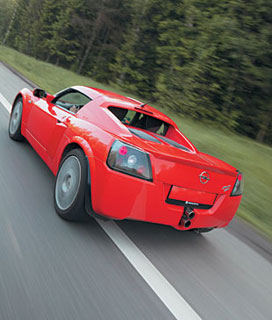 Opel Speedster Turbo.
Opel Speedster Turbo. Gasoline engine with turbocharged
Working volume (cube. Cm) 1998
Power (hp at rpm) 200 at 5500
Moment (nm at rpm) 250 at 1950
Rear-wheel drive
5-speed gearbox mechanical
Length / Width / Height (mm) 3786/1708/1117
Wheel base (mm) 2330
Mass Curb (kg) 1005
Maximum speed (km / h) 243
Acceleration up to 100 km / h (c) 4.9
Fuel consumption (city / highway, l / 100 km) 11.9 / 6.5
Price in Moscow $ 56,000
A source: "Autopilot"


